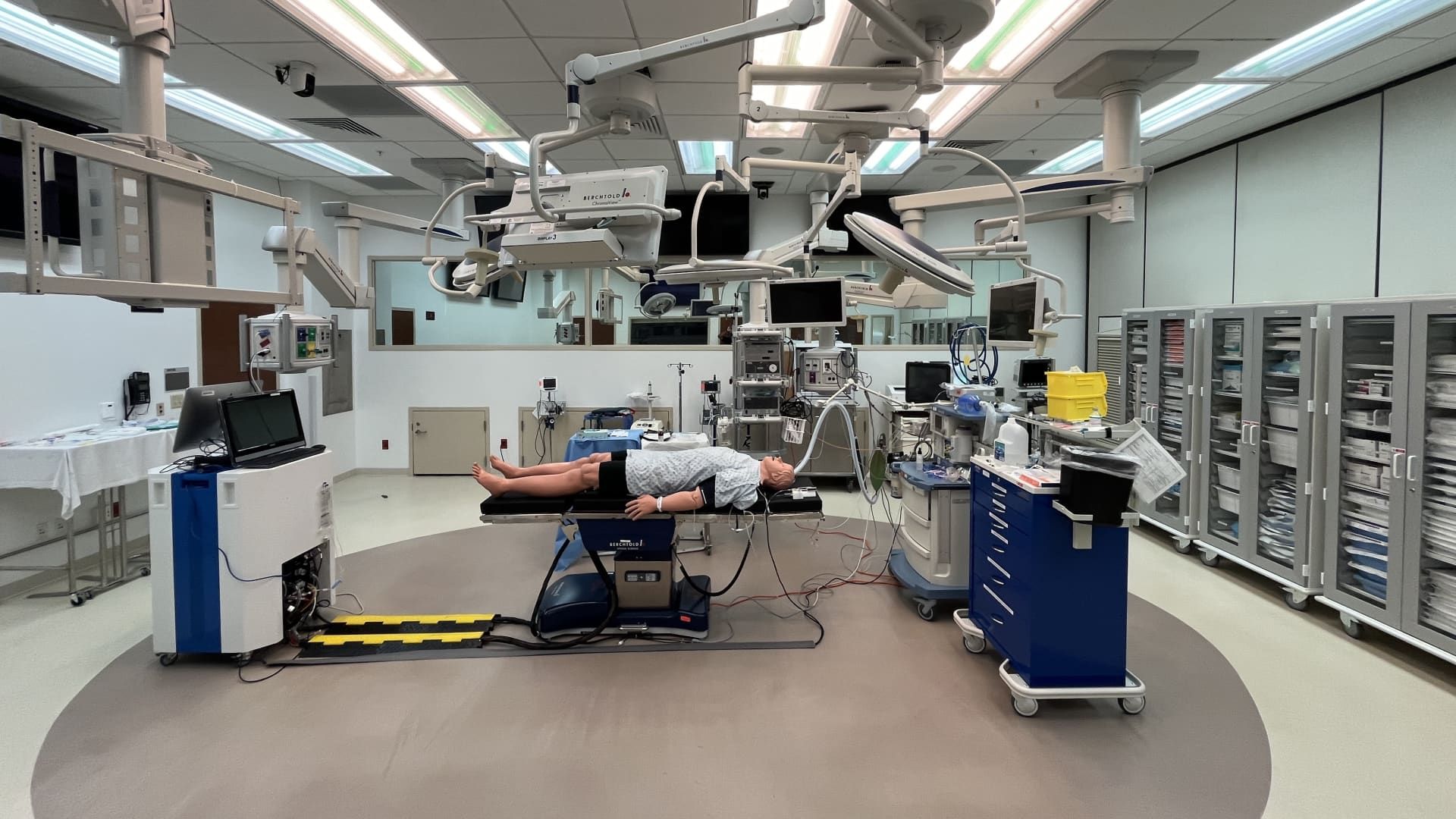An operating room at SimVET
Courtesy: SimVET
Inside a sprawling $43 million Veterans Affairs facility equipped with operating rooms, intensive care units and an outpatient clinic, there are no patients. At least, no real patients.
The 53,000-square-foot building is located minutes from Orlando International Airport in Florida and is called the National Simulation Validation, Evaluation and Testing Center, or SimVET. It serves as the primary facility where teams of frontline VA health care workers travel to practice procedures and test new technologies, all without posing unnecessary risks to patients.
For example, if a team of doctors wants to fine-tune their response to opioid overdoses or test a new AI tool, they can repeatedly simulate the process in SimVET. VA officials told CNBC that by practicing in a controlled environment, health care workers can problem-solve and ensure new ideas are feasible and safe to implement.
SimVET, which opened in 2016, is an example of how simulation in healthcare has become increasingly common and sophisticated in recent years. At a time when healthcare systems are looking to evaluate hundreds of new artificial intelligence tools that have recently come to market, centers like SimVET can help cut through the noise.
SimVET facilities in Orlando, Florida
Courtesy: SimVET
The Veterans Health Administration serves 9 million veterans at 172 medical centers across the United States. Each medical center has a simulation program, and some have dedicated space on site.
The SimVET facility in Orlando is the largest simulation center within the VA “by far,” and also one of the largest in the country, said Dr. Scott Wiltz, medical director of the VA's Simulation Learning, Evaluation, Assessment and Research Network, or SimLEARN.
Simulating high-risk scenarios is common in the military and in industries such as aeronautics, where pilots can spend hours practicing on flight simulators.
In the healthcare field, hospital systems and medical schools have long relied on professional actors to help train doctors, and virtual reality headsets are becoming an increasingly popular tool for practicing surgery. But SimVET takes it a step further.
The goal is usually to get “as close as possible.” [to] “a level of realism as high as possible,” Wiltz told CNBC in an interview.
“The operating rooms are a great example,” Wiltz said. “We have two fully staffed operating rooms, all the equipment that is normally used: lights, arms, real anesthesia machines. We even have a mannequin that realistically responds to anesthesia.”
CNBC visited SimVET in March, and the mannequins are a real presence at the facility. They have a variety of skin tones, hairstyles and facial features, and some are programmed to talk, move and develop complications. One “older” mannequin at the facility has more pronounced wrinkles and veins, and another can give birth to a “baby” mannequin.
Wiltz said the numbers are supposed to represent the VA's veteran population as well as the country's population at large. There are “more than two dozen” mannequins at the facility, he said.
A mannequin at the SimVET facilities
Courtesy: SimVET
In addition to its unusual patients, SimVET is home to plenty of familiar-looking healthcare scenes. Fluorescent lights line a long hallway filled with exam rooms and operating rooms packed with machinery that look like they're straight out of a nearby hospital.
To an unsuspecting visitor, the facility would look very much like a real medical center. The building's numerous classrooms and educational spaces are the only slight clue.
“The diversity of the space that we have, the realism that it brings, really gives you the feeling that you can actually care for patients in that building,” Wiltz said. “And we do, except our patients are mannequins and actors.”
A space to “fail safely”
The SimVET building in Orlando, Florida
Courtesy: SimVET
Wiltz said SimVET employs about 60 full-time staff, and they typically work on several pilot projects at once. National program offices and front-line workers within the VA approach SimVET with ideas for simulations, and sometimes facility employees themselves are inspired, he said.
SimVET can offer services with funding directly through the VA, so Wiltz said it often makes more sense for these groups to turn to them rather than trying to pay someone outside of the government.
Amanda Borchers, patient safety manager at the Lexington VA Medical Center in Kentucky, was part of a surgical emergency team that visited SimVET in May of last year. She said they were looking to improve their response to unexpected complications that can arise during surgery, so they reached out to SimVET with ideas in the winter of 2023.
Borchers said some of the highest-risk veterans in his population have respiratory, cardiac and circulatory issues that can cause sudden problems during procedures. His team wanted to develop a new protocol to better prepare for some of those challenges, such as how to quickly retrieve blood and get it to an operating room.
SimVET leaders helped Borchers and his four other teammates write several simulations before they arrived on site, and also connected with several field experts from around the country.
The team spent a busy week at the SimVET facility: their first day started around a drawing table at 7am sharp, and then they spent hours going over different procedures and talking through problems with SimVET experts and employees.
“You can fail, but you have to do it safely, and then use that situation to create change. And then do it again and again,” Borchers told CNBC in an interview. “The transformation and what we could do in an unforeseen emergency was incredible.”
Borchers said he had participated in simulations before, but had never experienced anything comparable to SimVET. He said the facility mimics the environment he works in every day, which allowed him to practice “every detail” of what he routinely does.
“It's exactly the same,” he said. “You could actually perform surgery right then and there.”
An intensive care unit at SimVET
Courtesy: SimVET
At the end of the week, Borchers and his team left SimVET with the framework for a new medical code, which is a facility-wide response to a specific type of emergency. For example, television shows and movies often reference “code blue,” in which health care workers spring into action when a patient is in cardiac or respiratory arrest.
Borchers said the new code the team developed would be announced over loudspeakers as the “SET code,” which stands for “surgical emergency team.” He said it is designed to alert a dedicated team that provides support when unexpected complications occur during or immediately after surgery.
SimVET gave Borchers and his teammates the initial practice and confidence they needed for their idea, but they still had to get the rest of the Lexington VA Medical Center on board. They presented the code to their executive leaders and began deciding exactly which people and resources would respond to it.
Borchers said the medical center began running its own simulations and continued to fine-tune the code within In the fall, tests were conducted in small areas of the hospital. In the spring, they expanded their testing and began running simulations with the code throughout the facility.
The medical center is currently updating its paging system, and Borchers said the facility will simulate the code again once the new system is up and running. If all goes according to plan, the SET code will be used with real patients in the next two to three months.
Borchers said his ultimate goal is to see the SET code used at VA medical centers across the country, and staff in states including Tennessee, Mississippi, Louisiana, Arkansas and Texas have already participated in simulated training.
Wiltz said the code is on its way to becoming a national program at the VA.
“Fortunately, this wasn't the result of an adverse event, but of people saying, 'You know what, we're doing pretty well, but we think we can do even better,'” Wiltz said.












